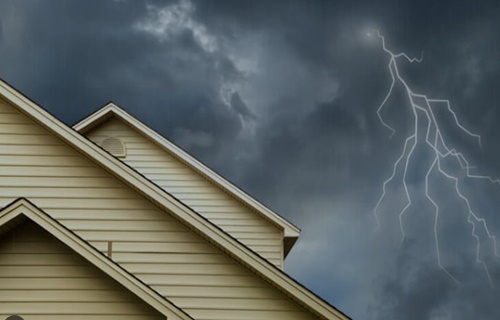Asbestos Damage During Storms

Springtime is in full swing, and while warmer days are welcome, the potential storms are not. Extreme weather conditions like storms can cause damage to asbestos-containing building materials, which may release toxic asbestos fibers into the air, posing the danger of inhalation or ingestion.
Many homes and commercial buildings built before the 1980s were made with asbestos materials, so any damage and deterioration will increase the material's friability. Products containing asbestos are considered safe as long as they are in good condition. Once broken, ripped, blown, burned, or washed away, they can release toxic asbestos fibers into the air.
Storms can cause damage by water through roof leaks and structural damage by the wind and disturb asbestos-containing materials. A short checking list can go a long way in preventing significant damages if you look for the signs of wear and tear in:
Proofing the electrical appliances is a crucial step to prevent fire which can cause further asbestos exposure risks.
Damaged Asbestos Can Travel Throughout Your Home
Natural disasters like storms pose dangers from the moment they occur, but people often don't consider health risks after a storm rips through their neighborhood. Asbestos exposure is not an immediate danger as live electrical wires, gas leaks, or unstable infrastructure is.
Any asbestos-containing material can become friable after a storm, and brittle asbestos products can crumble into fine dust under very light pressure. Some storms travel with high wind speed putting structures under considerable pressure. Once airborne, the microscopic asbestos particles remain in the air for long periods and can be inhaled by homeowners and neighbors. Storms can harm common household materials containing asbestos like:
- roofing felt
- pipe lagging
- block insulation
- adhesives
- ceiling products
- cement board
- flooring
- paints
- roofing
- wallboard
- insulation
- fireplace decorations
- taping compounds
- plasters
- electrical insulation
- electrical panels
- heating systems
- cooling systems
Inhaling asbestos fibers can lead to severe health conditions many years later. It is essential to consider the risk of asbestos exposure and prepare for prevention if you own a home built before 1980. You can identify asbestos-containing products in your house with the help of our guide.
Handling Storm Damaged Asbestos Safely
Because asbestos fibers are microscopic and travel by air or in dust clouds, you can be exposed without knowing. Homeowners of damaged properties face the risk of asbestos exposure when searching through debris or cleaning up storm damage. It is recommended to treat all storm-related debris as potentially asbestos-contaminated material.
If you suspect asbestos-containing materials during cleanup efforts, leave them alone. Stirring up asbestos-containing debris can produce airborne asbestos fibers and make exposure highly likely. Although hiring an asbestos abatement contractor for proper removal and disposal is the best solution, you can minimize asbestos exposure if you must move materials by considering these tips:
- wet debris first so the fibers are less likely to become airborne
- use only correctly fitted NIOSH-approved respirators
- do not use plain paper, fiber dusk masks, or other lower-grade air respirators, as they provide little or no protection from asbestos fibers
- wear additional protective gear, such as boots, coveralls, and gloves
- only disturb construction materials that must be removed and try not to cause further breakage
- double-bag all debris
- enclose the damaged area with plastic sheeting and duct tape to minimize dust
- wear disposable coveralls
- properly dispose of your clothes after removing the debris if you don't have coveralls
- be aware that washing clothes contaminated with asbestos dust can lead to exposure for you and your family members
Preparing an emergency kit can protect you from asbestos exposure in the aftermath of an extreme storm. Part of prevention is testing your home in time for asbestos - it is the only way to know if it contains the dangerous material. The tests are completed by licensed professionals who are able to locate the hazardous mineral, and they will also be able to remove it safely.
